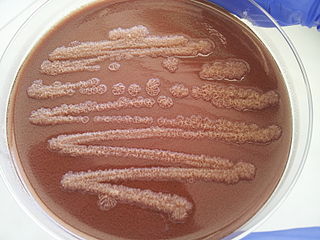
Acidobacteriota is a phylum of Gram-negative bacteria. Its members are physiologically diverse and ubiquitous, especially in soils, but are under-represented in culture.
Pseudomonas alcaligenes is a Gram-negative aerobic bacterium used for bioremediation purposes of oil pollution, pesticide substances, and certain chemical substances, as it can degrade polycyclic aromatic hydrocarbons. It can be a human pathogen, but occurrences are very rare. Based on 16S rRNA analysis, P. alcaligenes has been placed in the P. aeruginosa group.
Pseudomonas citronellolis is a Gram-negative, bacillus bacterium that is used to study the mechanisms of pyruvate carboxylase. It was first isolated from forest soil, under pine trees, in northern Virginia, United States.

Pseudomonas stutzeri is a Gram-negative soil bacterium that is motile, has a single polar flagellum, and is classified as bacillus, or rod-shaped. While this bacterium was first isolated from human spinal fluid, it has since been found in many different environments due to its various characteristics and metabolic capabilities. P. stutzeri is an opportunistic pathogen in clinical settings, although infections are rare. Based on 16S rRNA analysis, this bacterium has been placed in the P. stutzeri group, to which it lends its name.

Enterobacter cloacae is a clinically significant Gram-negative, facultatively-anaerobic, rod-shaped bacterium.
Variovorax paradoxus is a gram negative, beta proteobacterium from the genus Variovorax. Strains of V. paradoxus can be categorized into two groups, hydrogen oxidizers and heterotrophic strains, both of which are aerobic. The genus name Vario-vorax and species name para-doxus (contrary-opinion) reflects both the dichotomy of V. paradoxus metabolisms, but also its ability to utilize a wide array of organic compounds.
Alcanivorax pacificus is a pyrene-degrading marine gammaproteobacterium. It is of the genus Alcanivorax, a group of marine bacteria known for degrading hydrocarbons. When originally proposed, the genus Alcanivorax comprised six distinguishable species. However, A. pacificus, a seventh strain, was isolated from deep sea sediments in the West Pacific Ocean by Shanghai Majorbio Bio-pharm Technology Co., Ltd. in 2011. A. pacificus’s ability to degrade hydrocarbons can be employed for cleaning up oil-contaminated oceans through bioremediation. The genomic differences present in this strain of Alcanivorax that distinguish it from the original consortium are important to understand to better utilize this bacteria for bioremediation.
Streptomyces malaysiensis is a streptomycete bacterium species. At maturity, the aerial hyphae of this species differentiates into tight, spiral chains of rugose, cylindrical spores. Its type strain is ATB-11T.
Gordonia westfalica is a rubber-degrading actinomycete bacterium. It is aerobic and Gram-positive, with type strain Kb2T.
Opitutus terrae is an obligately anaerobic bacterium first isolated from rice paddy soil, hence its epithet. It is coccus-shaped and is motile by means of a flagellum. Its type strain is PB90-1T. Its genome has been sequenced.
Labrys portucalensis is a Gram-negative, rod-shaped, non-motile, non-spore-forming and aerobic bacteria from the family Xanthobacteraceae which has been isolated from polluted soil in Estarreja in Portugal. Labrys portucalensis has the ability to degrade fluorobenzene.
Jongsikchunia kroppenstedtii is a bacterium from the genus Jongsikchunia which has been isolated from polluted stream in Gumi, Korea. Jongsikchunia kroppenstedtii has the ability to degrade phenol.
Gordonia neofelifaecis is a bacterium from the genus Gordonia which has been isolated from faeces from the leopard in the Sichuan Province in China.
Gordonia paraffinivorans is a bacterium from the genus Gordonia which has been isolated from the Daqing Oil Field in China. Gordonia paraffinivorans has the ability to degrade hydrocarbon.
Gordonia rhizosphera is a bacterium from the genus Gordonia which has been isolated from rhizosphere soil from a mangrove plant in Japan.
Gordonia soli is a bacterium from the genus of Gordonia which has been isolated from soil in Taiwan.
Gordonia sp. nov. Q8 is a bacterium in the phylum of Actinomycetota. It was discovered in 2017 as one of eighteen new species isolated from the Jiangsu Wei5 oilfield in East China with the potential for bioremediation. Strain Q8 is rod-shaped and gram-positive with dimensions 1.0–4.0 μm × 0.5–1.2 μm and an optimal growth temperature of 40 °C. Phylogenetically, it is most closely related to Gordonia paraffinivorans and Gordonia alkaliphila, both of which are known bioremediators. Q8 was assigned as a novel species based on a <70% ratio of DNA homology with other Gordonia bacteria.
Sphingobacterium olei is a Gram-stain-negative, rod-shaped, and non-motile bacterium. It was first isolated from oil-contaminated soil in Daqing oil field, China. S. olei has been found to be able to degrade herbicides quizalofop-p-ethyl and diclofop-methyl. Before a name was given, S. olei was designated as strain HAL-9T. The species name olei means "of oil" in Latin.

The species Rhizorhabdus wittichii, formerly Sphingomonas wittichii, is a Gram-negative, rod-shaped motile bacterium, with an optimum growth temperature at 30 °C. It forms a greyish white colony. It has been found to have a 67mol% of DNA G+C content.
Biodesulfurization is the process of removing sulfur from crude oil through the use of microorganisms or their enzymes.



